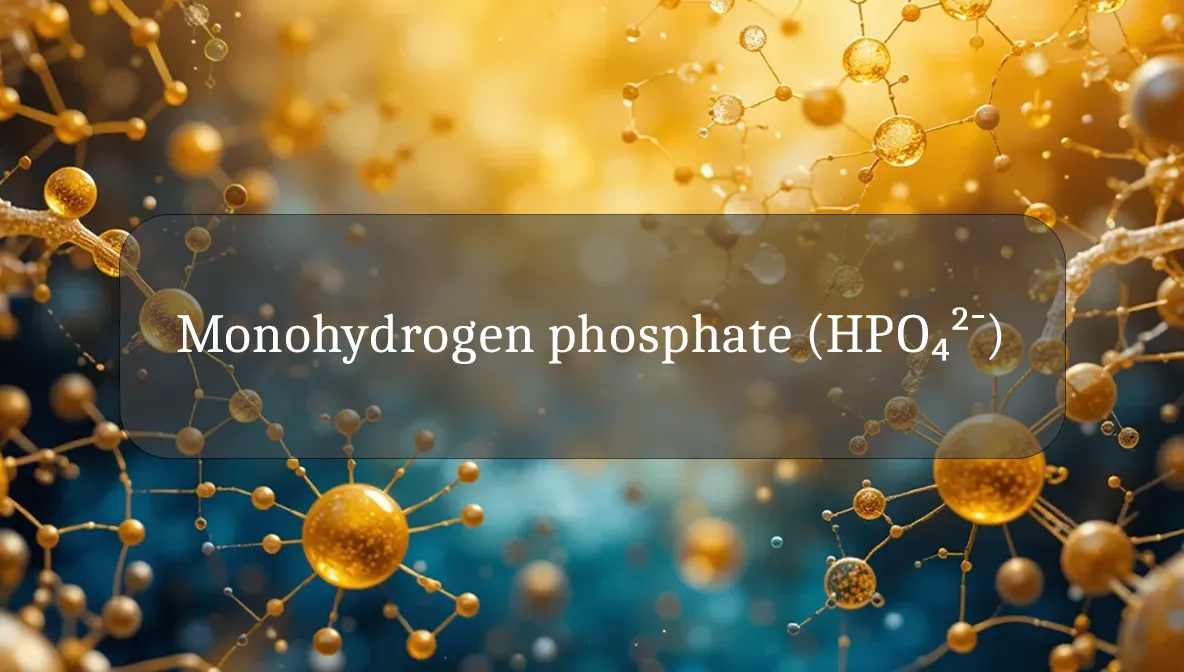Your Body’s pH Stabilizer and Immune Ally
Monohydrogen phosphate (HPO₄²⁻) is like a steady hand in your body, helping maintain pH balance and supporting cellular processes that bolster immune function. As a key component of the phosphate buffer system and a source of phosphorus, it plays an indirect but crucial role in health. For health-conscious individuals eager to optimize wellness, understanding HPO₄²⁻ can provide insights into how your body stays balanced and resilient. Let’s explore what HPO₄²⁻ is, its relevance to immune health, and how to support its function for a thriving you.
Identity and Function
Monohydrogen phosphate (HPO₄²⁻) is an anion derived from phosphoric acid (H₃PO₄), existing in equilibrium with dihydrogen phosphate (H₂PO₄⁻) in blood and cells. It’s a vital part of the phosphate buffer system, which maintains blood pH (7.35–7.45) by neutralizing excess acids or bases. HPO₄²⁻ is found in blood, bones, and intracellular fluids, providing phosphorus for energy production (ATP), DNA/RNA synthesis, and cell signaling. Regulated by kidneys, intestines, and diet, HPO₄²⁻ ensures metabolic and immune stability [1].
Immune Role and Benefits
HPO₄²⁻’s role in immunity is indirect but essential, supporting the cellular environment for immune function:
- pH Homeostasis: HPO₄²⁻ buffers blood pH, optimizing immune cell function (e.g., T-cells, macrophages), as pH imbalances impair their activity [2].
- Energy Supply: Phosphorus from HPO₄²⁻ fuels ATP production, powering immune responses like phagocytosis or cytokine release [1].
- Cell Signaling: HPO₄²⁻ contributes to phosphorylation, activating immune pathways (e.g., in TLRs or cytokine receptors) [3].
- Bone Health: HPO₄²⁻ supports bone mineralization, aiding immune cell production in bone marrow [4].
- Health Implications: Low phosphate (hypophosphatemia) weakens immunity, increasing infection risk. High phosphate (hyperphosphatemia) may cause inflammation, stressing immunity, often linked to kidney issues [5].
Balanced HPO₄²⁻ levels create a stable environment for robust immunity.
Ways to Support Function
You don’t consume HPO₄²⁻ directly, but you can support its levels:
- Phosphorus-Rich Diet: Include dairy (e.g., milk, 250 mg/cup), fish (e.g., salmon, 200 mg/3 oz), or nuts (e.g., almonds, 137 mg/oz) for phosphate balance (RDA: 700 mg/day for adults) [2].
- Hydration: Drink 8–10 cups water daily to support kidney regulation of HPO₄²⁻ [3].
- Balanced Diet: Vitamin D (e.g., salmon, 600 IU/3 oz) and magnesium (e.g., spinach, 80 mg/cup) enhance phosphorus absorption [4].
- Exercise: Moderate activity (e.g., walking, 150 min/week) supports bone and phosphate metabolism [1].
Signs of Dysfunction
HPO₄²⁻ imbalances (reflecting phosphate levels) can disrupt health:
- Dysfunction Signs:
- Fatigue, muscle weakness, or bone pain (from low phosphate, impairing immune function) [2].
- Frequent infections or slow recovery (linked to hypophosphatemia’s effect on immunity) [3].
- Itching, joint pain, or inflammation (from high phosphate, often in kidney disease) [4].
- Causes: Poor diet, kidney dysfunction, diabetes, or medications (e.g., diuretics) cause low phosphate. Kidney failure or excess phosphorus intake cause high phosphate [5].
- Disease Link: Hypophosphatemia is tied to immune suppression or malnutrition. Hyperphosphatemia is linked to kidney disease, inflammation, or cardiovascular issues [3].
Consult a doctor for persistent fatigue, infections, or kidney symptoms.
Promoting Optimal Immune Health
Support HPO₄²⁻’s role with these habits:
- Phosphorus-Rich Foods: Aim for 700 mg/day from dairy (e.g., yogurt, 300 mg/cup), poultry (e.g., chicken, 200 mg/3 oz), or legumes (e.g., lentils, 178 mg/cup) [2].
- Support Absorption: Include vitamin D (e.g., eggs, 40 IU/yolk) and magnesium (e.g., pumpkin seeds, 180 mg/oz) [1].
- Antioxidants: Berries, greens, or turmeric support immune cells reliant on HPO₄²⁻ [3].
- Hydration: Drink 8–10 cups water daily for kidney function [2].
- Exercise: Yoga or cycling (150 min/week) supports phosphate metabolism [4].
- Limit Phosphorus Excess: Avoid processed foods high in phosphate additives (e.g., sodas) [5].
- Sleep: Get 7–8 hours rest for metabolic stability [3].
- Stress Management: Mindfulness or meditation (5–10 min/day) supports kidney and immunity [4].
No specific HPO₄²⁻ intake exists; focus on balanced phosphorus.
Safety and Stressors
HPO₄²⁻ is safe, but imbalances stress immunity:
- Stressors:
- Nutrient Imbalances: Low vitamin D or magnesium impairs phosphorus absorption [2].
- Kidney Dysfunction: Disrupts HPO₄²⁻ regulation [3].
- Toxins: Heavy metals (e.g., lead) stress kidneys [5].
- Lifestyle: Poor diet, dehydration, or stress [4].
- Safety Considerations:
- Medical Conditions: Kidney disease or diabetes require medical care [3].
- Toxins: Use filtered water, avoid polluted areas [5].
- Medications: Diuretics or phosphate binders affect levels; follow guidance [2].
- Who’s at Risk? Those with kidney issues, poor diets, or toxin exposure.
Fun Fact
HPO₄²⁻ is like a cellular harmonizer! It keeps your blood’s pH in perfect pitch, letting your immune system sing its protective tune [1]!
Citations
- Alberts, B., et al. (2014). Molecular Biology of the Cell. Garland Science.
- National Library of Medicine. (2022). Phosphate Metabolism and Immune Function.
- Mayo Clinic. (2024). Hypophosphatemia and Hyperphosphatemia.
- National Institute of Health. (2023). Phosphorus and Immune Health.
- Centers for Disease Control and Prevention (CDC). (2023). Environmental Toxins and Kidney Health.

